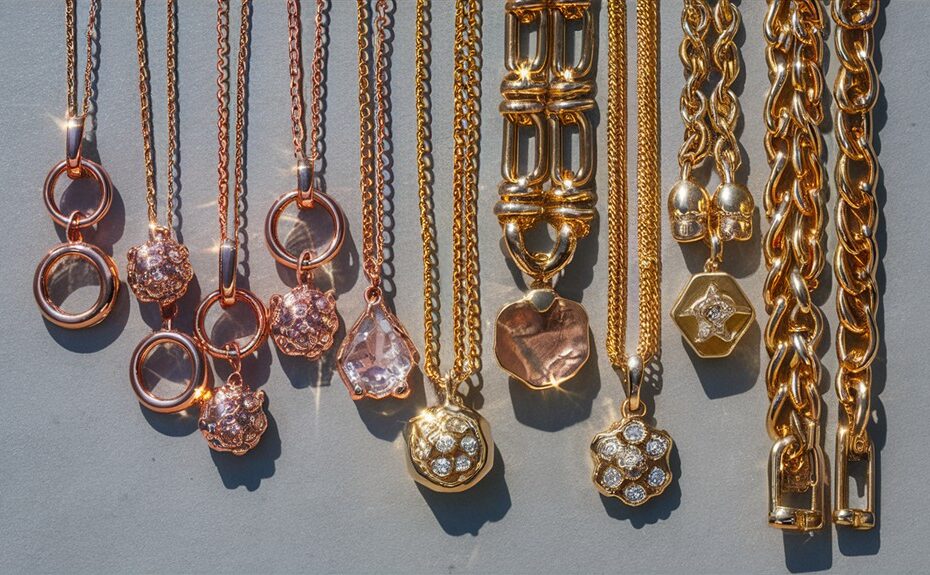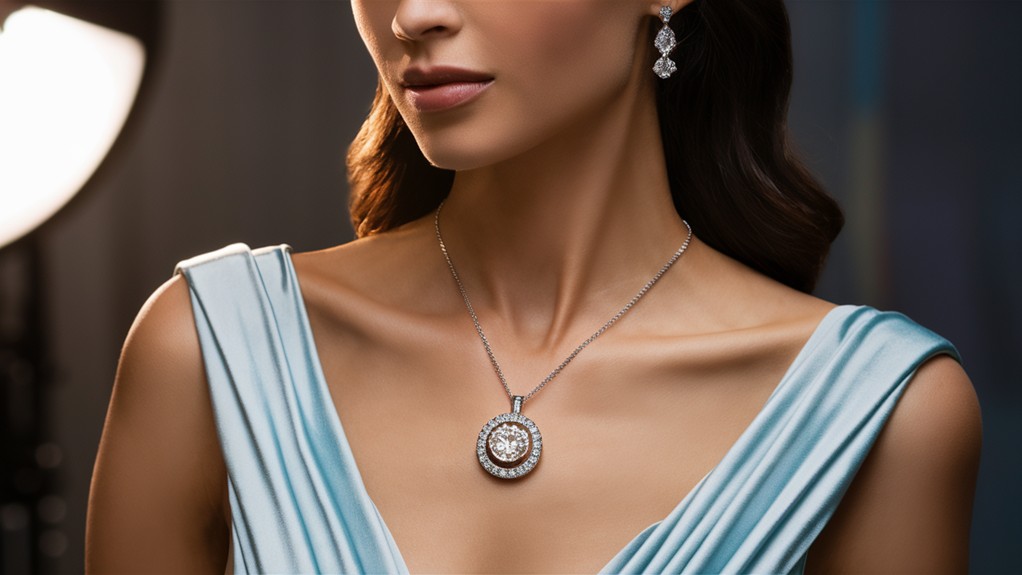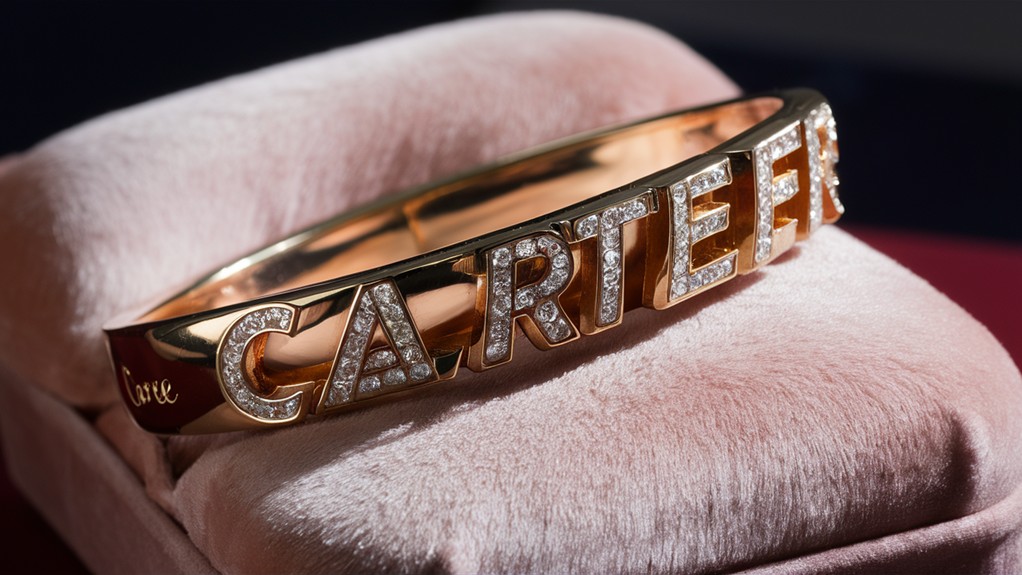When you're faced with choosing between rose gold and yellow gold, you're not just picking a color—you're selecting a piece of history, artistry, and personal expression. Both metals have unique qualities that can complement your style and lifestyle in different ways. From their distinct compositions to their varied aesthetic appeals, these precious metals offer more than meets the eye. As you consider your options, you'll find that each has its own set of advantages and potential drawbacks. The decision isn't always straightforward, but understanding the subtleties of rose gold and yellow gold will help you make an informed choice that you'll treasure for years to come.
Our Highlighted Points
- Rose gold contains copper, offering a unique pinkish hue and enhanced durability compared to yellow gold.
- Yellow gold is a classic choice with a warm tone, often preferred for traditional jewelry designs.
- Rose gold generally suits both cool and warm skin tones, while yellow gold complements warm skin tones best.
- Rose gold is typically more affordable due to its copper content, whereas yellow gold's price varies with karat purity.
- Both metals are available in various karat options, balancing purity, durability, and cost for different preferences and lifestyles.
History and Composition of Gold
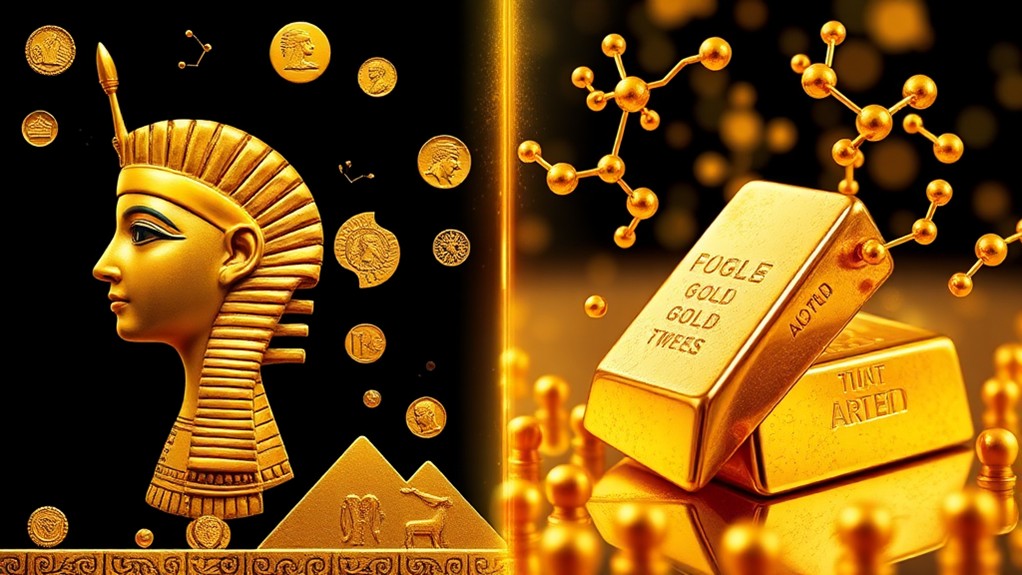
With gold being a highly valued metal, you'll want to understand its composition and history. As a chemical element with the atomic number 79, gold has a rich history dating thousands of years.
Pure gold is a soft, dense metal that's often mixed with other metals to make it stronger and more durable.
To determine the purity of gold, it's measured in karats (k), with 24-karat gold being the purest. Some common purity levels of gold are:
- 24-karat gold: 99.9% gold
- 18-karat gold: 75% gold mixed with other metals
The mix of metals in gold affects its color and strength, with different types of gold having unique traits resulting from different mixes and purity levels.
While rose gold and yellow gold are popular types of gold, yellow gold is the classic form, known for its warm, bright color and often looks the purest because of its high gold content.
Understanding the composition and history of gold will help you make an informed decision when choosing between rose gold and yellow gold. With this knowledge, you'll be better equipped to select the type of gold that suits your needs.
Variations of Gold Alloys
You'll find that gold alloys come in a variety of forms, each with its own unique characteristics. The most common variations are yellow gold, rose gold, and white gold, each offering distinct aesthetic appeal and potential skin tone compatibility.
Yellow gold, a classic precious metal, combines pure gold with copper and zinc to create a warm, bright hue that exudes timeless elegance. Rose gold, in contrast, is primarily an alloy of gold and copper, resulting in a unique color with a pinkish tinge that has gained popularity in recent years.
When considering gold alloys for jewelry, keep in mind these factors:
- Gold content: Higher karat ratings indicate greater purity and value
- Durability: Lower karat alloys tend to be more resistant to wear and tear
- Color preference: Choose based on personal style and skin tone compatibility
- Maintenance: Different alloys may require varying levels of care
The karat system measures the purity of gold alloys, with 24K representing pure gold. However, 18K gold, containing 75% gold content, is commonly used in both yellow and rose gold jewelry because of its balance of purity and durability.
White gold, another popular variation, is created by alloying pure gold with metals like palladium or nickel, often rhodium-plated for added shine.
Durability and Skin Tone Considerations
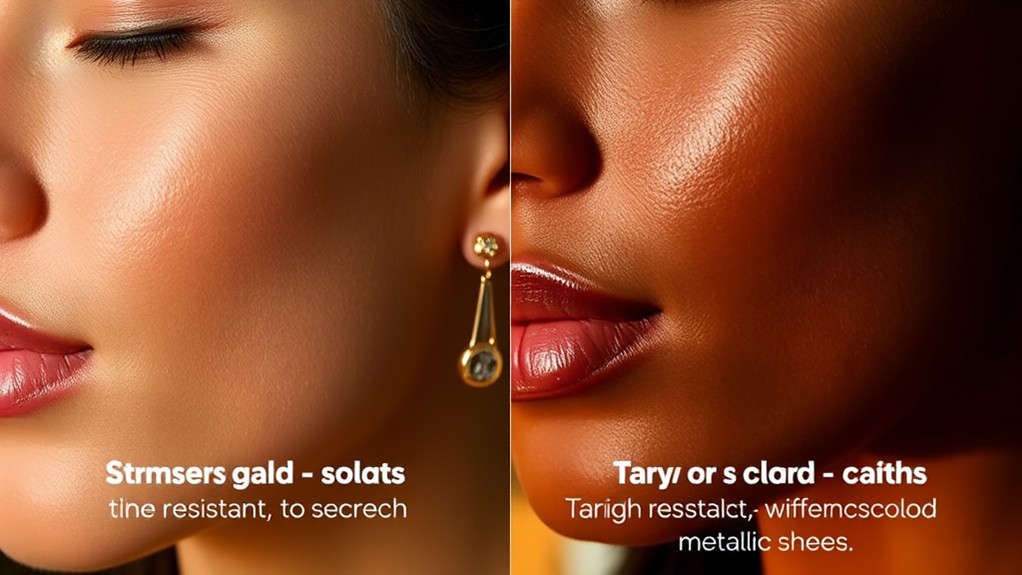
When selecting between rose gold and yellow gold, durability and skin tone compatibility are key factors to assess.
Rose gold typically offers superior durability owing to its higher copper content, which improves its resistance to wear and tear. However, the durability of yellow gold can vary depending on its karat level, with lower karats like 9k potentially offering more strength owing to increased alloy content.
Consider your skin tone when choosing between these precious metals. Yellow gold generally complements warm skin tones, while rose gold's versatility suits both cool and warm complexions.
If you have metal sensitivities, rose gold may be a better option as it's often regarded as hypoallergenic. In contrast, yellow gold can sometimes cause allergic reactions in sensitive individuals because of other alloy metals used in its composition.
It's essential to note that rose gold may darken or tarnish over time as a result of its copper content. Regular cleaning can help maintain its appearance, while yellow gold is more resistant to tarnishing.
When making your decision, weigh these factors carefully to guarantee you select the gold alloy that best meets your needs for durability and skin tone compatibility.
Cost and Lifestyle Factors
Cost considerations and lifestyle factors play a significant role in choosing between rose gold and yellow gold. When comparing the cost of gold, rose gold is typically more affordable than yellow gold because of its copper content, making it a budget-friendly option for jewelry enthusiasts.
The price of both metals fluctuates based on purity level, with 14k gold generally being less expensive than 18k gold, regardless of color. Furthermore, the price of white gold tends to be slightly higher than that of yellow gold due to the additional cost of alloying it with palladium or nickel to achieve the desired color. On the other hand, sterling silver is often more affordable than both types of gold. When considering the sterling silver vs white gold comparison, it’s important to take into account factors such as durability, maintenance, and personal preferences in terms of color and shine.
Your lifestyle and daily wear habits should likewise influence your decision. Rose gold is more resistant to scratches and dents, making it suitable for those with active lifestyles.
Consider these factors when making your choice:
- Your budget constraints and financial goals
- Your personal style and how each metal complements your wardrobe
- Your daily activities and potential exposure to wear and tear
- Your long-term maintenance preferences and willingness to care for the jewelry
Both rose gold and yellow gold offer unique aesthetic appeals, allowing you to express your individuality.
Keep in mind that market factors such as demand, inflation, and geopolitical events can affect the price of both metals, so it's important to research current trends before making a purchase.
Aesthetic Appeal and Applications
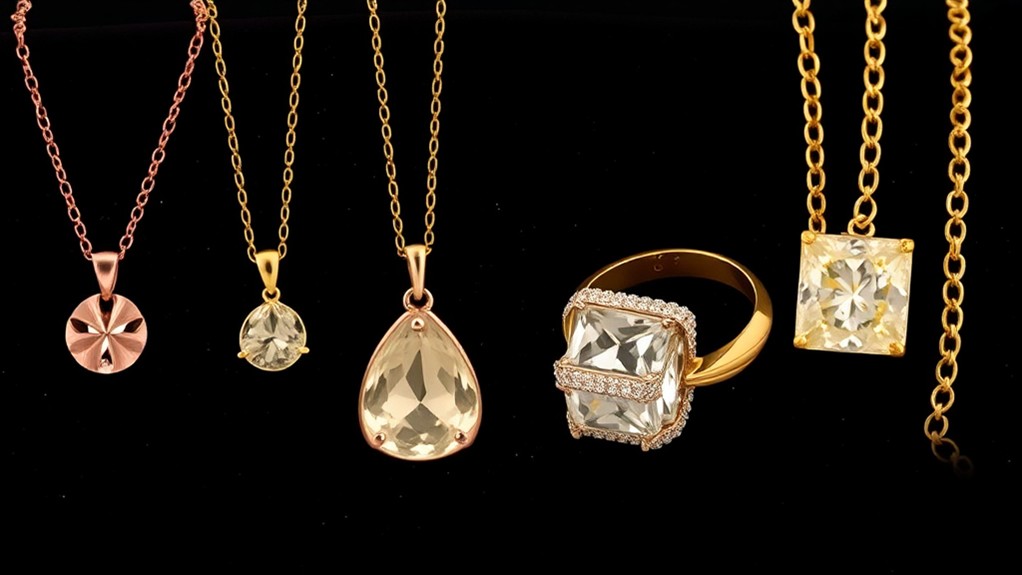
How do rose gold and yellow gold differ in their aesthetic appeal and applications? These two precious metals offer distinct visual characteristics and adaptability in jewelry design.
Rose gold, created by alloying gold with copper, provides a unique pinkish hue that adds a romantic touch to multiple pieces. This modern aesthetic makes it particularly popular for engagement rings and contemporary jewelry designs.
In contrast, yellow gold maintains a classic and timeless appeal, often preferred for traditional wedding bands and vintage-inspired pieces.
The alloy compositions of these metals greatly influence their appearance:
- Rose gold's copper content creates its distinctive color, complementing cool skin tones.
- Yellow gold's alloys with copper and zinc improve its warm, bright color, favoring warm skin tones.
Both metals are available in numerous karat options, with 18k versions containing 75% pure gold.
Their aesthetic versatility allows for application in different jewelry styles:
- Rose gold: Trendy, contemporary look
- Yellow gold: Classic elegance and traditional charm
When choosing between rose gold and yellow gold, consider your personal style preferences, skin tone, and the intended use of the jewelry piece to make an informed decision.
Frequently Asked Questions
What Metal Looks Best With Rose Gold?
You'll find that white gold and silver look stunning with rose gold, creating a beautiful contrast. Yellow gold likewise pairs nicely, enhancing the warmth. For a modern touch, try platinum. Don't forget copper and brass for a romantic look.
Should I Get Rose Gold or Yellow Gold Necklace?
You should choose based on your skin tone and style preference. If you want versatility, go for rose gold. For a classic look, pick yellow gold. Consider durability too; rose gold's more scratch-resistant. Ultimately, select what you'll love wearing.
Does Gold or Silver Look Better With Rose Gold?
Both gold and silver can look stunning with rose gold. You'll find gold creates a warm, harmonious blend, while silver offers a striking contrast. Your choice depends on your personal style and the look you're trying to achieve.
What Skin Tone Does Rose Gold Look Best On?
Rose gold looks great on different skin tones. You'll find it flatters fair skin with rosy undertones, improves warm and cool complexions, adds warmth to dark skin, and complements olive tones. It's versatile enough to suit most people beautifully.
